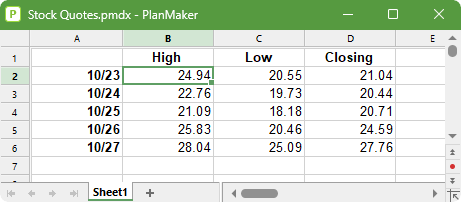You can choose the ribbon command View | group Windows | Freeze cells ![]() to fix the first rows and/or columns of a table on the screen. This means that they no longer move when scrolling through the table, but permanently stay in place.
to fix the first rows and/or columns of a table on the screen. This means that they no longer move when scrolling through the table, but permanently stay in place.
If, for example, you have entered labels for rows or columns of a worksheet, you can freeze those labels so that they are always visible.
Enabling freezing
To freeze rows or columns, you can use the following options:
▪Only freeze the top row: Use the small arrow of the icon Freeze cells, and select the entry Freeze top row. It does not matter which cell you have previously selected.
▪Only freeze the first column: Use the small arrow of the icon Freeze cells, and select the entry Freeze first column. It does not matter which cell you have previously selected.
▪Freeze the top row and first column: Select the aforementioned two commands in succession to combine freezing the top row and the first column.
▪Freeze any number of lines: If you want to freeze the first rows (without freezing columns), proceed as follows:
| In the row header on the far left, select the row directly below the rows that you want to freeze. Then click directly on the Freeze cells icon. |
| Alternatively: Use the icon's small arrow and select the entry Freeze at current position. |
▪Freeze any number of columns: If you want to freeze the first columns (without freezing rows), proceed as follows:
| In the column header at the top, select the column to the right of the columns that you want to freeze. Then click directly on the Freeze cells icon. |
| Alternatively: Use the icon's small arrow and select the entry Freeze at current position. |
▪Freeze any number of rows and columns: If you want to freeze several first rows and columns, place the cell frame in the cell right below the range that you want to freeze. Then click directly on the Freeze cells icon.
| Alternatively: Use the icon's small arrow and select the entry Freeze at current position. |
The rows and/or columns are now frozen. They remain in their original location when you scroll through the worksheet.
Tip: You can also use the ![]() icon in the bottom right corner of the document window to freeze rows or columns. Simply click on this icon and then drag it to the desired location.
icon in the bottom right corner of the document window to freeze rows or columns. Simply click on this icon and then drag it to the desired location.
Disabling freezing
If you have frozen rows or columns, the Freeze cells ![]() icon is darker in order to indicate that freezing is enabled. To disable it, click directly on the icon itself – the rows/columns will no longer be frozen.
icon is darker in order to indicate that freezing is enabled. To disable it, click directly on the icon itself – the rows/columns will no longer be frozen.
Alternatively: Use the icon's small arrow and select the entry Unfreeze cells.
Tip: A single mouse click on the ![]() icon in the bottom right corner of the document window will also disable freezing.
icon in the bottom right corner of the document window will also disable freezing.
An example
Assume you have the following worksheet:

Note that both the columns and the rows are labeled. To freeze the labels, proceed as follows:
▪The column labels (High, Low, etc.) are in the first row of the table.
| To freeze them, select the second row by clicking on its row header (the button labeled "2" to the left of the row). |
| Then choose the ribbon command View | Freeze cells. |
▪The row labels (10/23, 10/24, etc.) are in the first column of the worksheet.
| To freeze them, select the second column (column B) by clicking on its column header (the button labeled "B" above the column). |
| Then choose the ribbon command View | Freeze cells. |
▪To freeze both rows and columns, click on cell B2 and choose the ribbon command View | Freeze cells.
Tip: Since the top row and first column are involved in this example, you might as well use the commands Freeze top row and Freeze first column by clicking on the arrow of the icon Freeze cells.
If you want to unfreeze, click on the Freeze cells icon again.